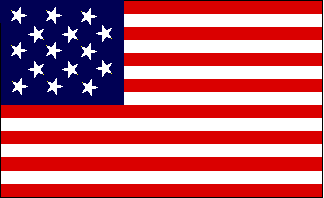
The Star Spangled Banner
Flags before 1840 (when the sewing machine was introduced), as all other fabric constructions of the day, were made by hand sewing the various components into a single article. Most flags of the eighteenth and early nineteenth century were either of two types; one was the "ceremonial" standard, which was generally made of expensive leaded silk often emblazoned with fancy allegorical or patriotic designs that were embroidered or painted on in oils, often by some very talented or famous artist. These standards or colors are typified by those used by the U.S. Army and the Militia of that era. The other type was the utilitarian flag, made of pieces of woolen bunting stitched into the final pattern and used on ships, at forts and anywhere a flag display was needed.
During the Revolutionary War, the flagmakers of Philadelphia were kept especially busy by Congress, who was trying to outfit an army and a navy. The existing records give us the names of a few of these artisians, Margaret Manny, Cornelia Bridges, Elizabeth Ross, Anne King, Anne Ward and Rebecca Young. As I stated, Elizabeth Ross is known by most but it is Rebecca Young and her daughter and grand daughter that I am writing about.
Rebecca advertised as a flagmaker in the Philadelphia Newspapers during the Revolutionary War and Theodore Gottlieb, who did considerable research on the subject, states that she was paid "at least thirty times" for making flags for the Quartermaster Department of the Continental Army and the Pennsylvania Navy. After the War, in October 1784, she was paid for sewing the Standard of the First United States Regiment commanded by Lt. Colonel Josiah Harmar. After this, there are no further records of her but her daughter Mary continued the tradition by making one of America's most famous flags.
Mrs. Mary Young Pickersgill of Baltimore, a "maker of ships banners and flags," assisted by her daughter Mrs. Caroline Purdy, under contract to the United States Government in 1813 manufactured the U.S. Flag that has now become known as the "Star Spangled Banner" and was used as the garrison flag of Fort McHenry during the British siege of 175 years ago. This flag, originally measuring 30 by 42 feet (since then reduced to about 28 by 34 feet) was begun in July 1813 and finished on August 19, when she wrote a receipt for payment of $405.90 for it. It contained four hundred yards of first quality single ply 18 inch woolen bunting; the 15 stars made out of cotton, each measuring two feet in diameter; the blue union measuring approximately 16 by 20 feet and eight red and seven white 2 foot wide stripes; the whole sewed by hand with linen thread. Caroline Purdy later wrote that her mother devoted particular attention to reinforcing the topping or heading of the flag. According to the Smithsonian Institution, who now has custody of the flag, Mary was asked to do the work by Commodore Joshua Barney (who was shortly to become the best known hero defending Washington, D.C.) and General John Stricker of the Maryland Militia.

Fort McHenry was commanded during the seige by Major (later Lt. Colonel) George Armistead, who was presented with the flag after the War of 1812 and it remained in his family for many years. The flag bears his signature and the date of the bombardment. On September 14, 1824, in connection with a reception of General Lafayette, the flag was brought back to Fort McHenry and displayed. In 1861 his widow bequeathed it to their daughter Mrs. William Stuart Appleton, and on her death July 25, 1878 it was left to her son, Eben Appleton of Yonkers, N.Y. He loaned the flag to the Smithsonian in 1907 and made it an outright gift December 19, 1912, where it has been preserved and is displayed in its current size in the National Museum of History and Technology against a backdrop outlining the original size.
Return to the US Flag History Index Page
To the Vexillology Page
To the Maine Flags Pages
To the New England Vexillological Assn. Page
To the New England Journal of Vexillology Page
To the New England Flag Page